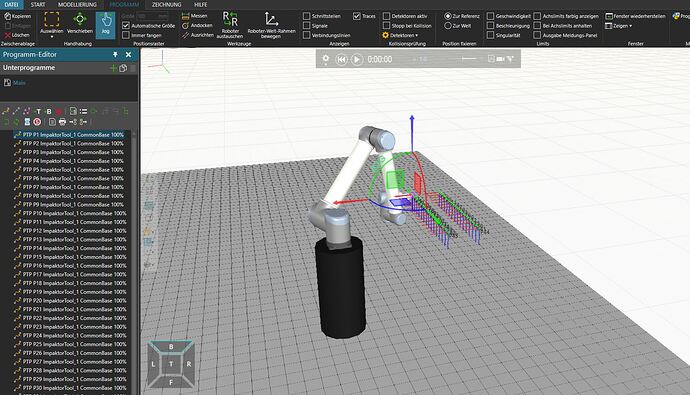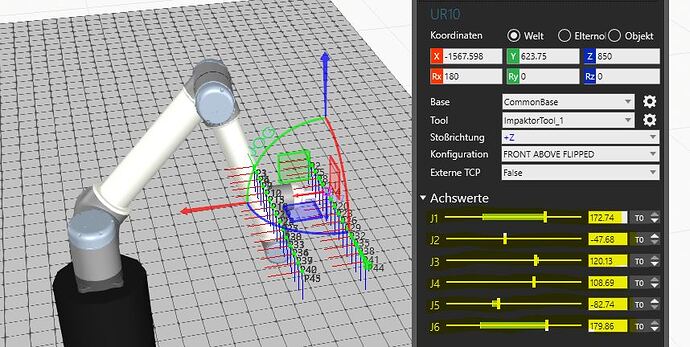The recommended courses can help because the following might read like gibberish.
About the API in relation to linear and PTP motion statements, each point is a vcPositionFrame object that has a JointValues property, which gives you a list of the joint values for that target. The assumption would be the motion statement was made with the robot in your setup.
In relation to points in a Path statement, each point is a vcSchemaPositionFrame. You need to do a little more work to get the joint values for each point since a point gives you a position matrix and any external joint values. So the example in vcSchemaPositionFrame has a section on how to create a vcMotionTarget, and that target can be used in conjunction with robot controller to find the joint values. For custom statements using schema, the workflow would be similar, but there are probably easier ways to get the values, such as using the vcMotionInterpolator object.
This is a helpful question @TStotz since I noticed vcHelpers.Selection does not have methods for returning all positions and their joint values.
There, of course, is the option to record the joint values of robot during simulation, but that is trivial. Here is a code example that records using sampling interval, but if you drive or jog a robot to a programmed point the vcDof object for each joint of robot (internal and external) can be used to get the value.
from vcScript import *
SAMPLING_INTERVAL = 0.1
def getRobotJointValues():
joint_values = [d.VALUE for d in dofs]
return joint_values
def stopRecordingJointValues(program_executor):
#just an event handler to stop recording joint values
suspendRun()
def OnRun():
##recorded joint values
#while app.Simulation.IsRunning:
# print getRobotJointValues() #write to file, note behavior, etc.
# delay(SAMPLING_INTERVAL)
pass
comp = getComponent()
app = getApplication()
robot = app.findComponent("Generic Articulated Robot")
controller = robot.findBehaviour("Controller")
joints = controller.Joints
dofs = [j.Dof for j in joints]
executor = robot.findBehaviour("Executor")
executor.OnProgramFinished = stopRecordingJointValues
recorded_jv = [[0.0, 0.0, 90.0, 0.0, 0.0, 0.0],[0.0, 2.1119999999999988, 88.0899798038463, 0.0, 4.820922531023192, 0.0],[0.0, 8.447999999999995, 82.3599192153852, 0.0, 19.283690124092768, 0.0],[0.0, 23.137002028808805, 69.07569074172633, 0.0, 52.813302263737555, 0.0],[0.0, 30.36425338657955, 62.53961306368592, 0.0, 69.31047030731943, 0.0],[0.0, 30.91558837890625, 62.65484619140625, 0.0, 69.41049194335938, 0.0],[0.0, 32.46856689453125, 64.78207397460938, 0.0, 65.73031616210938, 0.0],[0.0, 37.327117919921875, 67.9119873046875, 0.0, 57.741851806640625, 0.0],[0.0, 38.958099365234375, 68.32638549804688, 0.0, 55.696441650390625, 0.0],[0.0, 37.17315673828125, 67.860595703125, 0.0, 57.947174072265625, 0.0],[0.0, 33.78765869140625, 66.01943969726562, 0.0, 63.173828125, 0.0],[0.0, 30.873138427734375, 62.58172607421875, 0.0, 69.526123046875, 0.0],[0.5162845265931946, 30.68658447265625, 62.24810791015625, 0.0, 70.04623413085938, 0.0],[9.72522573987986, 30.68658447265625, 62.24810791015625, 0.0, 70.04623413085938, 0.0],[22.26451988207098, 30.68658447265625, 62.24810791015625, 0.0, 70.04623413085938, 0.0],[46.18529419434725, 30.68658447265625, 62.24810791015625, 0.0, 70.04623413085938, 0.0],[62.185294194347264, 30.68658447265625, 62.24810791015625, 0.0, 70.04623413085938, 0.0],[86.18529419434728, 30.68658447265625, 62.24810791015625, 0.0, 70.04623413085938, 0.0],[102.18529419434729, 30.68658447265625, 62.24810791015625, 0.0, 70.04623413085938, 0.0],[123.60580873966178, 30.68658447265625, 62.24810791015625, 0.0, 70.04623413085938, 0.0],[131.90636022294524, 30.68658447265625, 62.24810791015625, 0.0, 70.04623413085938, 0.0],[135.12451755269726, 30.643537552467265, 62.387184397011424, -0.8264927964098103, 69.86271927933883, -0.8264927964098103],[135.12451722306437, 30.116253280204358, 64.09074051295111, -10.950251959022037, 67.61483500542037, -10.950251959022037],[135.12451602531212, 28.20031588548187, 70.28077317318876, -47.73589070294041, 59.446934375792694, -47.73589070294041],[135.1245148645087, 26.34348230042353, 76.2798525626289, -83.38674738316328, 51.53100129244232, -83.38674738316328],[135.12451313316214, 23.574001754792203, 85.22752229159404, -136.5602545867535, 39.72433059708786, -136.56025458675347],[135.1245122906234, 22.226267716508236, 89.58179698620123, -162.43649542414124, 33.97875783975631, -162.43649542414124]]

